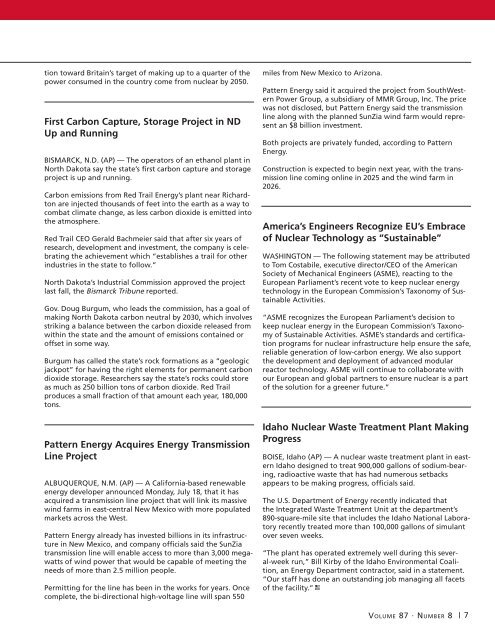CEAC-2022-08-August
You also want an ePaper? Increase the reach of your titles
YUMPU automatically turns print PDFs into web optimized ePapers that Google loves.
tion toward Britain’s target of making up to a quarter of the<br />
power consumed in the country come from nuclear by 2050.<br />
First Carbon Capture, Storage Project in ND<br />
Up and Running<br />
BISMARCK, N.D. (AP) — The operators of an ethanol plant in<br />
North Dakota say the state’s first carbon capture and storage<br />
project is up and running.<br />
Carbon emissions from Red Trail Energy’s plant near Richardton<br />
are injected thousands of feet into the earth as a way to<br />
combat climate change, as less carbon dioxide is emitted into<br />
the atmosphere.<br />
Red Trail CEO Gerald Bachmeier said that after six years of<br />
research, development and investment, the company is celebrating<br />
the achievement which “establishes a trail for other<br />
industries in the state to follow.”<br />
North Dakota’s Industrial Commission approved the project<br />
last fall, the Bismarck Tribune reported.<br />
Gov. Doug Burgum, who leads the commission, has a goal of<br />
making North Dakota carbon neutral by 2030, which involves<br />
striking a balance between the carbon dioxide released from<br />
within the state and the amount of emissions contained or<br />
offset in some way.<br />
Burgum has called the state’s rock formations as a “geologic<br />
jackpot” for having the right elements for permanent carbon<br />
dioxide storage. Researchers say the state’s rocks could store<br />
as much as 250 billion tons of carbon dioxide. Red Trail<br />
produces a small fraction of that amount each year, 180,000<br />
tons.<br />
Pattern Energy Acquires Energy Transmission<br />
Line Project<br />
ALBUQUERQUE, N.M. (AP) — A California-based renewable<br />
energy developer announced Monday, July 18, that it has<br />
acquired a transmission line project that will link its massive<br />
wind farms in east-central New Mexico with more populated<br />
markets across the West.<br />
Pattern Energy already has invested billions in its infrastructure<br />
in New Mexico, and company officials said the SunZia<br />
transmission line will enable access to more than 3,000 megawatts<br />
of wind power that would be capable of meeting the<br />
needs of more than 2.5 million people.<br />
Permitting for the line has been in the works for years. Once<br />
complete, the bi-directional high-voltage line will span 550<br />
miles from New Mexico to Arizona.<br />
Pattern Energy said it acquired the project from SouthWestern<br />
Power Group, a subsidiary of MMR Group, Inc. The price<br />
was not disclosed, but Pattern Energy said the transmission<br />
line along with the planned SunZia wind farm would represent<br />
an $8 billion investment.<br />
Both projects are privately funded, according to Pattern<br />
Energy.<br />
Construction is expected to begin next year, with the transmission<br />
line coming online in 2025 and the wind farm in<br />
2026.<br />
America’s Engineers Recognize EU’s Embrace<br />
of Nuclear Technology as “Sustainable”<br />
WASHINGTON — The following statement may be attributed<br />
to Tom Costabile, executive director/CEO of the American<br />
Society of Mechanical Engineers (ASME), reacting to the<br />
European Parliament’s recent vote to keep nuclear energy<br />
technology in the European Commission’s Taxonomy of Sustainable<br />
Activities.<br />
“ASME recognizes the European Parliament’s decision to<br />
keep nuclear energy in the European Commission’s Taxonomy<br />
of Sustainable Activities. ASME’s standards and certification<br />
programs for nuclear infrastructure help ensure the safe,<br />
reliable generation of low-carbon energy. We also support<br />
the development and deployment of advanced modular<br />
reactor technology. ASME will continue to collaborate with<br />
our European and global partners to ensure nuclear is a part<br />
of the solution for a greener future.”<br />
Idaho Nuclear Waste Treatment Plant Making<br />
Progress<br />
BOISE, Idaho (AP) — A nuclear waste treatment plant in eastern<br />
Idaho designed to treat 900,000 gallons of sodium-bearing,<br />
radioactive waste that has had numerous setbacks<br />
appears to be making progress, officials said.<br />
The U.S. Department of Energy recently indicated that<br />
the Integrated Waste Treatment Unit at the department’s<br />
890-square-mile site that includes the Idaho National Laboratory<br />
recently treated more than 100,000 gallons of simulant<br />
over seven weeks.<br />
“The plant has operated extremely well during this several-week<br />
run,” Bill Kirby of the Idaho Environmental Coalition,<br />
an Energy Department contractor, said in a statement.<br />
“Our staff has done an outstanding job managing all facets<br />
of the facility.”<br />
Volume 87 · Number 8 | 7

















